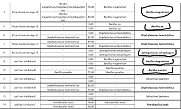This page is currently being updated and will be asap completed!

Investigations, explanations, laboratory tests and factors,
which may lead to infection with soil-borne biofilm bacteria
Topics:
- Bioinsecticides -
- Pheromones and sweat -
- Stress slowly kills the body -
- Pesticides makes us sick and weak -
- GMOs and GV food - a ticking time bomb -
Prehistory:
As a technician, I always tried to be as scientific as possible in order to be able to present an evidence-based study that can also be traced. I spent years studying medicine, epidemiology, microbiology and all sorts of bacteria, fungi and protists, and last but not least, whether such microorganisms, which are used en masse in agriculture worldwide, are guilty of this terrible disease. My research included many hours under the microscope, scouring scientific articles in several languages, as well as constant contact with worldwide sufferers to gain more knowledge about all disease symptoms, etc.
Of course, I also wondered whether causes other than bioinsecticides, etc., such as bioweapons, could be considered. But without falling into the swamp of conspiracy theories. Since in addition to biotech companies, the U.S. military and U.S. government agencies were constantly on my site and often also tried to hack my website stupidly (more about it later). The fact is that such infections have certainly occurred in humans over the centuries or millennia, but probably only sporadically, perhaps even minor epidemics that have substantiated, and did not flare up as they did, which has now become a pandemic, also because of our travel behaviour, etc. in modern times.
So something must have happened somewhere that caused so many Indvidus (people and animals) to be affected by this disease. If it is not a bioweapon, then it must be something that has been mass-applied into nature, and perhaps with a certain momentum of its own, has spread even further than the polluters thought. Thus, perhaps unintentionally, so many individuals were infected by it.
So my first step was the isolation of filaments and bacteria and examination of filaments by means of gas-chromatographs. I sent dozens of filament samples to laboratories, all of which had insufficient results. Although certain values were found in the gas-chromatograph, but they were insufficient to continue with these expensive processes. After a few years and rainfall I almost wanted to give up, because my first guesses practically dissolved into air.
Until I tried to change the test procedures, because even usual laboratory cultures did not work in petri dishes. Therefore, I avoided sending samples to human laboratories and tried it with veterinary laboratories. Initially, not much came out of it after dozens of samples. Until I came up with the idea to have the samples grown at a lower temperature. So I literally took my last samples out of the fridge, which had been stored there as the last reserve for almost 8 years.
I asked the lab technicians to cultivate the samples at room temperature or 26-28 degrees Celcius. After only 2 days, a call came from the lab that it worked this time. The result was what I had always suspected, the bacterium Rhizobium radiobacter (old name: Agrobacterium tumifaciens)! The bacterial model organism par excellence, which is used for all kinds of agro-applications by biotech companies, which often already caused human infections.
Source: Treatment of Rhizobium radiobacter bacteremia- more cases on this site
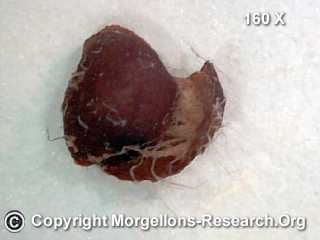
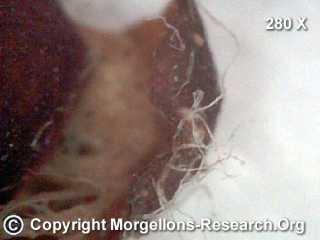
Send skin sample for the laboratory with the bacterium Rhizobium radiobacter.
Clearly visible are the bacterial filaments, which are literally woven with the skin piece
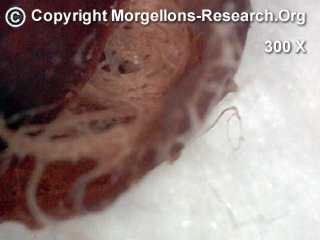
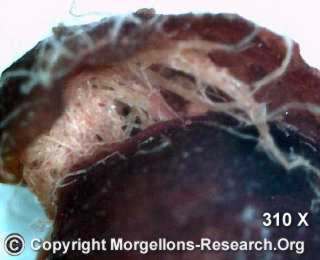
bears similarities to Rhizobium radiobacter, also growing out of a piece of skin
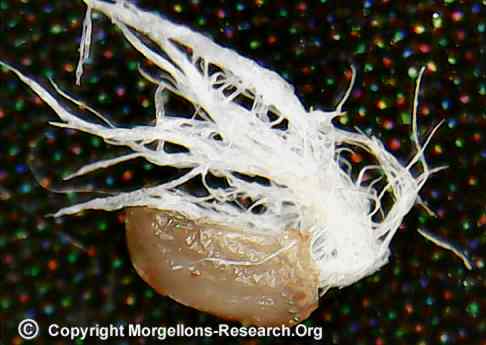
USA. In this case, this rare bacterium Elizabethkingia anophelis was transmitted by mosquitoes, hence the addition of "anophelis", which caused illness and death in a retirement home.
Source: http://www.nbcnews.com/health/health-news/wisconsin-investigates-mysterious-infection-n531236
Source: https://www.theatlantic.com/science/archive/2017/05/elizabethkingia-anophelis-wisconsin/528081/
Source: https://www.dhs.wisconsin.gov/disease/elizabethkingia.htm
It is also questionable how such rare bacteria, which were cultivated from filaments, can come from the skin of worldwide sufferers? Global pollution from space travel, contamination, laboratory errors? More on that later!

Be that as it may, after submissions of samples sent worldwide, even more agrobacteria were revealed, all of which are considered usual soil bacteria and are ubiquitous, but are unfortunately also increasingly used for agroculture in recent decades. Soil-borne bacteria tend to remain in the soil, but commercialisation brings these bacteria in mass into the environment and that is the real problem here!
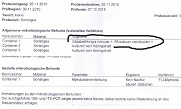
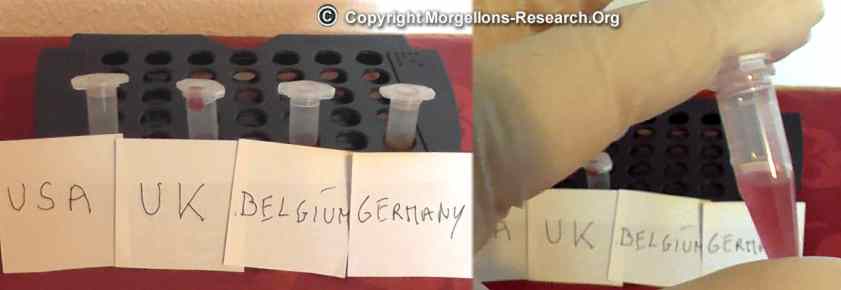
But this bacterium may have been the trigger by the ability to pass genes easily on to other bacteria, so say other bacteria have been genetically upgraded. Or his smaller brothers, e.g. the opponents (K84 + K1024) of Agrobacterium tumifaciens. Many now fulfill the properties of filamentous biofilms and much more!
Source: Isolation of Bacillus megaterium and its Commercial Importance
Source: Bazillus megaterium synthesize bioplastic (PHA)
Source: Filamentous form of Bazillus megaterium
Many of my laboratory tests showed that not a single bacterium is to blame for the whole misery, but many different filamentous biofilm bacteria. These are not only found in soil or fields, but can now also be found more frequently in sewage treatment plants, sewage sludge, lakes and other waters. But even in our everyday environment in cities, such bacteria are gradually spreading.
The already suffering individuals, whether humans or animals, become more affected by this new form of biofilm infection, due to a changed biochemistry (e.g. nitrostress, higher hormonal nitrogen production, histamine excess, cortisol deficiency), exactly this was the real focus of my further research in order to find out more in this regard.
Since bacteria love nitrogen, especially these biofilm bacteria, which are also called nitrogen-binding bacteria, host organisms that have a higher nitrogen production due to stress are favored. Normally, colonization in humans and animals is rather rare.
If agro-companies now take such nitrogen-binding bacteria out of the ground, process them (insert them into polymers) and then fill them in plastic bags and sell them in masses to farmers worldwide as bioinsecticides or nitrogen sources for the fields, then a worst-case-scenario arises here, which changes nature and causes still unknown diseases!
For decades, many companies and farmers have used many tons of different biological insecticides on global crops. Even GMOs (genetically modified organisms) to fight various pests.All biological insecticides - even the truly dangerous ones - have been approved without major problems by global environmental and health authorities, as so far there seems to have been no obvious danger to the environment, humans and animals. However, these websites are intended to refute this and show how large corporations can recklessly intervene in the environment and thus also destroy animal and human lives. This is really only possible with the consent of corrupt or ignorant authorities, who have no control bodies over them!
Is
Morgellons a bioinsecticide?
Nevertheless, I would like to report briefly on this and also on the other bioinsecticides in the further course, as hospital cases are increasing, where people have been infected with it. The presumption is that the masses of microorganisms that have been applied over the years may gradually become more and more dangerous for us!
Source: Metarhizium anisopliae F52 Biopesticide
Many different variants of Metarhizum anisopliae are used, some of which are highly virulent and also produce very different mycotoxins, as well as can naturally exchange their DNA with other microorganisms. In some variants, however, which have been genetically modified, sometimes no mycotoxins are expressed intentionally in order to exclude dangers to other living beings.
And in other versions, spider or scorpion genes are even inserted into dna to make them even more virulent and toxic. Ruthless pesticide companies use only such extremely virulent fungal insecticides as B. bassiana, M. anisopliae and Veicillium lecanii in Third World countries.
Source: Neurotoxins of scorpions to increase effect of mycoinsecticide
These fungi reproduce through spores and kill insects by producing a sticky substance that allows the spores to attach to the insect cutication and then penetrate the insect by germ tubulus. This fungus produces protoplasts, which allow the fungus to move similar to amoeba. The fungus colonizes an insect at all stages of insect development - whereby the insect is covered with a white covering on spores. All these types of fungi have been detected several times in the nasal and lung tissues of rodents, horses, cattle and also in humans.
Please wait - more is coming asap!
